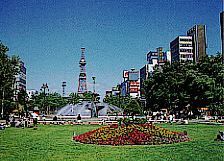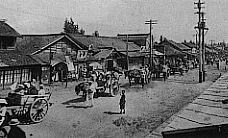北の生活文化(Current status of the Japanese Language in Hokkaido)
| There is little recognition on the part of people in Hokkaido that thier spoken language is one dialect of Japanese. The variety of Japanese spoken in Hokkaido has evolved from a mixture of dialects spoken by immigrants from various parts of Japan and through the creation of new wordings and different usages of conventional wordings. The Japanese spoken in Hokkaido is characterized by the fact that some words have been borrowed from the indigenous Ainu people. |
| Current status of the Japanese Language in Hokkaido |
 |
| 99. Odori Park in Sapporo |
In Aomori prefecture across the Tsugaru Straits from Hokkaido, there is a world of dialects which are so different from those spoken in Hokkaido that it is sometimes very difficult for people from other parts of Japan to understand the subject about which people are speaking. In comparison with the dialects spoken in Aomori, varieties of Japanese spoken in Hokkaido are much closer to the standardized Japanese which is spoken nationally and people from different areas of the island do not seem to have difficulty in communication. The Japanese spoken in Sapporo, in particular, is considered to be the closest to standard Japanese among the types of Japanese spoken in Hokkaido. Sapporo, often referred to as Little Tokyo, is quickly influenced by Tokyo fashions and enjoys active interactions with Tokyo through the world's busiest and most profitable air transport route which connects these two cities. Factors contributing to the integration of Tokyo speech and accent into the Japanese spoken by the under-30 age group in Hokkaido include the great influence of the Tokyo language style because of increasingly close communication and interactions and the widespread dissemination of TV after the Tokyo Olympic Games in 1964.
The varieties of Japanese spoken in the coastal areas of the island are, however, somewhat similar to the types of Japanese traditionally spoken in Honshu. On the other hand, the variations of Japanese heard in the inland area represent a mixture of different dialects brought by immigrants which later evolved into what they are today. The types of Japanese spoken in Hokkaido seem very close to standard Japanese, yet they possess a strong Hokkaido identity created or influenced by interactions with the language of the Ainu. |
| Language spoken in coastal areas |
Dialects spoken in the coastal areas are considered to from the basis of Hokkaido dialects as a whole. These dialects can be devided into the two groups of "Donan" or "southern dialect" and "Matsumae dialect." Both styles of language have cosiderable similarities in terms of pronunciation as exhibited in many words which are characterized by a nasal sound, less distinction between the sounds "shi" and "su" and a falling, ambiguous tone when people speak with a constricted voice using long-held syllables.
The "Donan dialect" shows clear evidence of elements which are deviations from the dialect spoken on the Shimokita peninsula in Aomori prefecture across the Tsugaru Straits and it has the strongest identity among Hokkaido dialects. The core of this dialect is represented by a language style spoken in Todohokke village.
The "Matsumae dialect" displays many elements of the dialect spoken on the Tsugaru peninsula in Aomori prefecture. This traditional dialect remains vividly alive in Shirakami in the town of Matsumae. The Shirakami area was tremendously influenced in culture and lifestyle through extended interactions involving trade and matrimony with the Tsugaru peninsula during the period from the Meiji to Taisho eras. The area served as a supply base of fresh and processed seafood to the capital of the Matsumae government and many merchants who used the dialects spoken in the Kyoto area presumably influenced the local language. |
| Language spoken in the inland area |
 |
| 103. Tonami in Kurisawa village(city), 1925 |
Immigrants from various parts of Japan concentrated in the inland areas of Hokkaido unlike in the coastal areas where immigrants were mostly from the Tohoku region.
The following passage highlights changes that took place in the development process of linguistic varieties brought from various origins by settlers in the inland areas. For example immigrants who were farmer soldiers or those who came individually, people originally from different areas formed settlements together and differences in language caused obstacles in leading lives together. Their efforts to arrive at a common language through which they could communicate led to a standardization of language.
Those immigrants who came in a group, on the other hand, built villages with members having the same origins and thier common dialects were maintained relatively easily. During the difficult times of the early settlements, their common dialects encouraged them to continue to pursue self-sufficient lives and strengthened the solidarity among them. People of the socond generation inherited their parents' original language while at the same time being involved with the further development of the dialect in the inland area. The third generation, who are senior citizens today, had less awareness of their origins and began to assimilate the language varieties spoken around them. The fourth and fifth generations, who make up the younger age group today, have adopted the standardized national language. Today, an increasing tendency is seen among people of this group to use words and expressions with a strong regional identity. |

